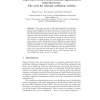Free Online Productivity Tools
i2Speak
i2Symbol
i2OCR
iTex2Img
iWeb2Print
iWeb2Shot
i2Type
iPdf2Split
iPdf2Merge
i2Bopomofo
i2Arabic
i2Style
i2Image
i2PDF
iLatex2Rtf
Sci2ools
DIS
2006
Springer
2006
Springer
Experiences from a Socio-economic Application of Induction Trees
This paper presents a full scaled application of induction trees for non-classificatory purposes. The grown trees are used for highlighting regional differences in the women's labor participation, by using data from the Swiss Population Census. Hence, the focus is on their descriptive rather than predictive power. A first tree provides evidence for three separate analyses for non-mothers, married or widowed mothers, and divorced or single mothers. For each group, trees grown by language regions exhibit fundamental cultural differences supporting the hypothesis of cultural models in female participation. From the methodological standpoint, the main difficulties with such a non-classificatory use of trees have to do with their validation, since the classical classification error rate does not make sense in this setting. We comment on this aspect and consider alternatives that are both consistent with our non-classificatory usage and easy to compute.
DIS 2006 | Grown Trees | Induction Trees | Theoretical Computer Science | Women's Labor Participation |
| Added | 22 Aug 2010 |
| Updated | 22 Aug 2010 |
| Type | Conference |
| Year | 2006 |
| Where | DIS |
| Authors | Fabio B. Losa, Pau Origoni, Gilbert Ritschard |
Comments (0)

